What Gladiolus Are And How To Get The Most From Them
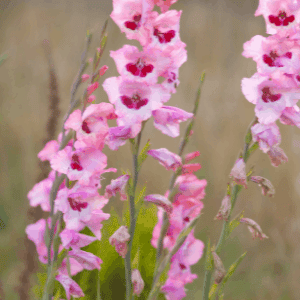
Do you need height in the garden?
Include gladiolus also called the sword lily in your summer garden. Also, if you like a dramatic display, ranging from 2′-5′ tall and with truly unusual bloom, in a great variety of colors – you will like Gladiolus.
Here is how and when to plant them for maximum beauty, indoors and out.
The Features Of The Gladiolus
Gladiolus produces sword-shaped leaves that grow in the form of upright fans in medium shades of green. Each fan has as many as nine leaves. The flowers held up on slender scapes are funnel shaped. (A scape is a single internode, a smooth little stem.) The blooms are large, fragrant. one-sided and bisexual. The petals and sepals are together called tepals, as they look almost identical. The long stems of unique blooms create a stunning image that no one will forget in your garden or arranged on your table.
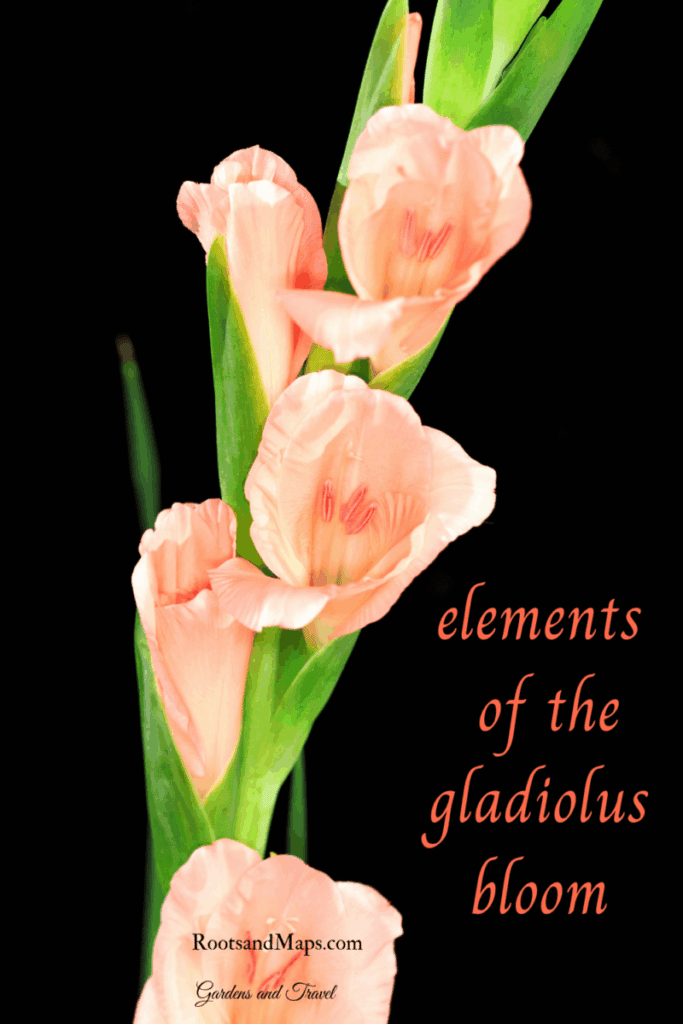
What Gladiolii Are And How We Got Them
The plant’s proper name is Gladiolus oppositiflorus, and we have been using them throughout the world, for about 250 years. This is one of the plants where everyday gardeners just took up the genus name as the popular name. The genus gladiolus consists of approximately 260 species. New varieties appear regularly. While most are native to South Africa, about ten species are native to Eurasia, and some are native to South America. All are members of the Iris family.
In this piece, we’ll refer to the plant as gladiola in the singular and gladioli in the plural. The bulb is specifically a corm, a small, flattish and oval kind of bulb.
How The Sword Lily Got To Us
Europeans discovered the original plants growing wild in South Africa where they were used as a food source. In Europe, botanists crossed them with other plants. The Netherlands was particularly active in this.
Appreciated around the world, they are now common to Asia, Mediterranean Europe, South Africa, and Tropical Africa.
What The Sword Lily Brings Us
Gladiolus grow from corms that renew each year and are remarkably inexpensive to buy.
Colors, blossom shapes, and the heights of the plants offer considerable variety. Colors include white, yellow, pink, lavender, rose, burgundy, purple, and green. Flower shapes include ruffled, wavy, or frilled edges.
When using the flower stalks in indoor arrangements, cut the stalk near the base of the plant. Remove any faded blossoms and cut 1″ from the bottom of the stalk every few days. This should lengthen the blooming period in your vase.
Varieties Of Gladiolus
You will have plenty of choices in color and size. The genius Gladiolus has more than 250 species that are endemic to southern Africa and there are 10 species from Eurasia.
There are many, varieties available to you. Carefully study the offerings of the best breeders. You can suit your own needs as to size, flower features, and bloom period.
Make Sure To Check The Sizes Of Gladiolus Before You Plant
The taller varieties provide back of the bed color and you can plant lower varieties in front to make a full display.
Some Choices-Short To Tall
We think of Gladiolus as tall plants of perhaps 4-5′. Some small cultivars with special features may help you grow some sword lilies.
Miniature Gladiolus, Smaller And More Cold Hardy
Miniature Gladiolus can be as short as 18-20″ tall. These are helpful to you if you want to plant in containers, or in the front of the border and do not require staking. In addition, the miniature gladiolus are more cold-hardy than the regular plants. Some are winter hardy in zones 4-5 instead of the much warmer areas 8-10.
This will take you to a grower’s list.
Very Tall Gladiolus
This example is a big beauty that gets to 60″tall. The link will give you all the details; please note that it is cold and hardy only to zone 8 and above. (You can grow them in colder climates, but you will store them for the winter.) They make excellent cut flowers, but you will need the big vase!
The Gladiolus Bulb-What It Is-How It Grows.
The gladiolus is produced by a corm, a kind of bulb which is flattish in shape. The top is a single point where the last stem came from. The bottom is disk-shaped and often has visible roots. If the corm is comfortable in its planted location, it will produce new corms which can be separated every few years.
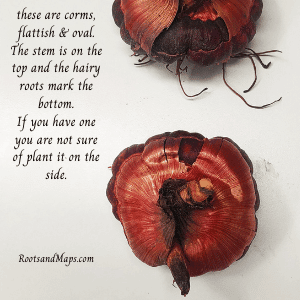
Here is an example of healthy corms. These are easy to identify top and bottom. If there are no hairy roots, look for the disk shape to mark the bottom.
Suppose you can’t figure it out; plant the corm on its side. It will figure it out!
Succession Planting Of Gladiolus
Each corm of gladiolus will produce about 2-3 stems of flowers, each stem can last two weeks. The corm will produce only one set of flowering stems each season. To keep these glorious blooms available all season, succession planting is a good idea.
In succession planting, instead of planting all the bulbs in spring, stagger them. Plant each group of corms at two-week intervals from spring to mid-July. The different varieties of gladiolus have their own timetables, but you can expect each planting to flower in about 90 days.
A Reason To Lift The Bulbs At Season End
Even if your garden is in a warm climate, you may choose to lift some or all of your bulbs to store for replanting next spring. Here’s why. If you leave the bulbs in the ground, they will all bloom next year at about the same time. By lifting and replanting, you will be able to practice succession planting next year, extending your blooming period.
Planting from corms is cost-effective and you might just add a few more every year. In our climate, we use a lot of caladiums for summer color. We leave them in place and keep adding each year. We always find room. In colder climates plant the caladium tubers in spring and lift them in fall. Caladiums provide all-day, every-day, color for months!
How To Use Gladiolus
Use Gladiolus in garden beds and containers (the shorter varieties work best) and make excellent cut flowers. I saw a designer clip off the individual blossoms to decorate a dining table. They were very effective.
- plant the tall flowers in groups for impact and to ensure that there are always flowers. Use groups of at least 10 plants together.
- Use the vegetable patch, as early season vegetables are finished use the space for succession planting of gladiolus for cutting.
How To Keep Gladiolus Upright
They grow on tall and straight stems and are susceptible to wind damage. The plants are very successful and decorative, lining a wall or fence. Some gardeners run a string across the line of Gladiolus and attached it to the wall to keep them in place.
if your numbers of plants are small you can stake them individually. High-volume growers use horticultural netting to enclose the growing plants. This comes in long rolls of 4″ squares. Use the netting, horizontally, tacked to stakes to enclose the vertical gladiolus stems. The product is called Hortinova netting and you can find it online.
Planting Gladioli in Containers
In cases where space is limited, or your climate is cold, try the flowers in pots. Us a well-draining potting soil and place the corms about 2″ apart and 6″ deep in the pot. You can plant several pots to use in succession all summer long. The corms can be stored over the winter.
Use only deep pots even for small spaces. The pots should be 10 or more inches in height.
Soil For Containers Of Gladioli
Any high-quality potting mix with good drainage will be successful. Here is what to look for in potting soils. Many gardeners have their own private mixes. One is 80% topsoil, 20% peat moss, and 20% composted cow manure.
How Many Corms To Use Per Pot?
- For a pot of 8-10″ in diameter 5 corms should fit well.
- For diameter of 14″ you can use 9 corms.
Using Gladioli As Cut Flowers
Cut the flowers at an angle and low. Leave about 1/3 of the stem intact and leave some foliage behind to feed the bulb.
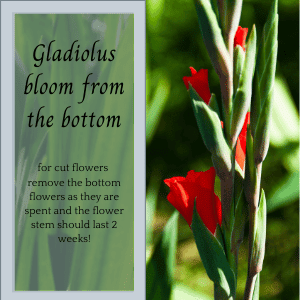
Once indoors, cut to the length you require, again at an angle, and remove spent or lower flowers. The tall spikes of flowers, look well in the vase with something to anchor the base of the arrangement. Consider using ferns or hosta leaves, as well as hydrangea or zinnia.
How To Extend The Life Of Cut Gladioli
Keep the cut flowers in a cool location to slow down the blooming process. You can refrigerate them overnight. Conversely, keep the cut stems in a warm place to speed up the process for a special event. Change the water every other day.
The Three Major Strains of Gladiolus
- The standard tall Gladiolus
- The Nanus- small and graceful
- The Butterfly Gladiolus-small and with a unique color pattern
- All gladiolus prefers well-drained and sandy soil.
Companion Plants For Gladiolus
Good companions for Gladiolus are, not surprisingly, more Gladiolus! This is particularly true if you enjoy cutting your gladiolus for bouquets. To have a steady supply of flowers, plant the corms in groups, one every two weeks until mid-summer.
Combine these tropical plants with tall zinnias, dahlia, peonies, and any other sturdy perennials that can support these tall plants.
Hardiness Zones
Gladiolus are hardy in zones 7 or 8-10; this means they can overwinter in the ground. How to be sure? Ask, do I have any chance of a hard frost? If the answer is yes, lift the corms and store them for the winter. (This is NOAA, showing the frost dates by region,)
Give the gladiolus 2-3″ of mulch once the shoots appear. This will reduce weeds, save moisture and keep the plant warm in the early or late season.
How to Plant Gladiolus
- To produce large plants, buy large corms of at least 1 1/4″. With this plant, bigger is better.
- Prepare to plant by loosening the soil to 12″-15″ deep. Add 2″-4″ of organic matter.
- Plant in well-drained, sandy, loamy soil, water well after planting but do not maintain wet conditions as the corms are inclined to rot if excessively wet.
- Plant 4′-6′ deep- these tall plants will welcome the support of a deep bulb. Place the corms in the hole, pointy side up and placing them 6″-10″ apart.
- If your soil is clay and does not drain well, plant in raised beds or containers
- If the plants are to be primarily used as cut flowers, planting in rows is most convenient
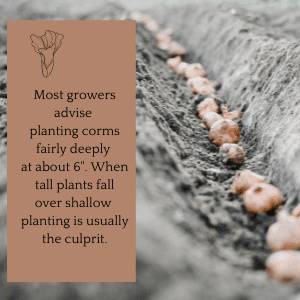
The Best Soil For Gladiolus
The best soil is sandy, loamy, and drains well. In the absence of draining soil use raised beds or containers until you can amend your soil.
When To Plant Gladiolus
Plant the gladiolus corms in springtime, two weeks before your last expected frost date. Because the gladiolus plant does not bloom all season, practice succession planting. This means to plant from spring until early July every two weeks.
This will allow you to stagger the bloom periods. You can also extend the bloom period by utilizing gladiolus varieties that bloom later in the year. Expect your plants to bloom about 90 days from the planting date.
Fertilizer
Fertilize with 5-10-10 or 5-10-5 fertilizer. Put the recommended amount in the hole before planting and mix soil and fertilizer well. This will prevent burning the corms. Fertilize when the flowers first appear.
Once the plants reach 6″ tall fertilize and continue until 3 weeks after flowering.
Pests and Diseases
Pests: the major problem is the Thrip, which damages leaves, flowers, and buds by sucking. Plants are rated for susceptibility to thrip damage. Check with your dealers. This is a discussion of thrip management.
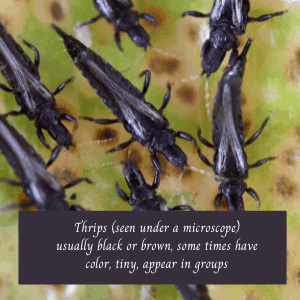
The thrip is tiny and hard to see, and the damage it does by piercing and sucking the plant foliage is hard to diagnose as it can look like a nutritional deficiency.
If you suspect thrips, place a white sheet of paper under the foliage and shake the plant over it. You should see little black dots dropping on the form.
Look for stippled or wrinkled leaves and black dots. Remove the damaged plant parts; you can also remove thrips with a stiff blast of water from the hose. There are both pesticides and beneficial insects for this.
Integrated Pest Management
Integrated Pest Management (IPM) is a process for solving pest problems while minimizing damage to people and the environment. Here is information from the IPM Institute. Also, use information from your state agricultural college. Access their research through your local county Extension service. If you have not tried them, you will be surprised by the amount of free, science-based information available.
Diseases-Several diseases can be a problem see this article from Penn State University
How to Lift and Store Gladiolus Corms for the Winter
The gladiolus is a perennial plant that dies back each fall to return in spring. It is hardy in zones 8-11, and the corms (the form of the bulb in which the gladiolus grows) can remain in the ground. In colder climates (numbers below 8), lift the bulbs each fall.
Carefully dig up the corms in early fall. Cut off the foliage about 1″-2″ in length. Dry, for 2-3 weeks in a warm, dry, well-ventilated place.
On the bottom of the corm, you will find the old dried “mother corm.” You can remove that and any of the tiny “baby” corms. The baby corms can be propagated, but it will take a few years to produce flowers.
Store the corms at 35-50 in a cool, dry place. Keep them in mesh bags.
Next year you can enjoy doing it all over again!
For other summer-blooming bulb, ideas check this
Summary
Gladiolus is a flower both stylish in bloom and practical as the corms will spread and return each year.
Other Summer Blooming Bulbs
